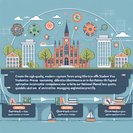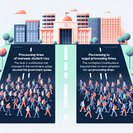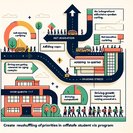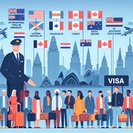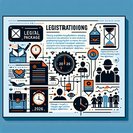
Australia’s opposition Coalition has decided it will not nominate a specific net-overseas-migration (NOM) figure this year, deferring the politically fraught question until closer to the 2028 federal election. Deputy Opposition Leader Sussan Ley told colleagues on 18 November that the party will instead publish a set of ‘guiding principles’ for immigration before Christmas.
Those principles, currently being modelled by the Coalition’s economic team, are expected to emphasise a smaller, more skilled intake; tougher compliance for student and working-holiday visas; and a complete overhaul of the Skilled Occupations List. Conservative back-benchers have been agitating for NOM to be cut from the government’s 260,000 projection for 2025 to below 200,000. Business groups and state treasuries, however, warn that an indiscriminate slash would intensify skills shortages in construction, care and clean-energy projects and reduce GDP growth.
![Coalition Shelves Migration Cap Decision, Eyes Tightening of Visa Categories]()
Internal modelling led by shadow treasurer Angus Taylor is examining several scenarios, including caps of 225,000, 200,000 and 180,000, and the fiscal impact of each. Early results suggest every 25,000-person cut removes roughly A$7 billion from the forward estimates over four years through lost income-tax and GST revenue. That finding is being used by moderates to argue for a ‘surgical’ rather than ‘chainsaw’ approach that targets low-wage segments of the program.
To blunt accusations of populism, the Coalition will link any reduction to infrastructure capacity, publishing an annual “carrying capacity” statement covering housing, hospitals, roads and classrooms. It is also preparing a crackdown on ghost colleges and fraudulent visa agents, aiming to halve student-visa rorting within two years. A proposal to fast-track visas in critical sectors—health, clean-tech and advanced manufacturing—is being retained to reassure employers.
If adopted, the strategy would represent the biggest recalibration of Australia’s migration settings since the post-COVID surge in 2022-23. Corporates planning talent pipelines should prepare for a more selective skilled visa regime, stricter labour-market testing and heightened documentary scrutiny, but not an immediate hard cap on overall numbers.
Those principles, currently being modelled by the Coalition’s economic team, are expected to emphasise a smaller, more skilled intake; tougher compliance for student and working-holiday visas; and a complete overhaul of the Skilled Occupations List. Conservative back-benchers have been agitating for NOM to be cut from the government’s 260,000 projection for 2025 to below 200,000. Business groups and state treasuries, however, warn that an indiscriminate slash would intensify skills shortages in construction, care and clean-energy projects and reduce GDP growth.

Internal modelling led by shadow treasurer Angus Taylor is examining several scenarios, including caps of 225,000, 200,000 and 180,000, and the fiscal impact of each. Early results suggest every 25,000-person cut removes roughly A$7 billion from the forward estimates over four years through lost income-tax and GST revenue. That finding is being used by moderates to argue for a ‘surgical’ rather than ‘chainsaw’ approach that targets low-wage segments of the program.
To blunt accusations of populism, the Coalition will link any reduction to infrastructure capacity, publishing an annual “carrying capacity” statement covering housing, hospitals, roads and classrooms. It is also preparing a crackdown on ghost colleges and fraudulent visa agents, aiming to halve student-visa rorting within two years. A proposal to fast-track visas in critical sectors—health, clean-tech and advanced manufacturing—is being retained to reassure employers.
If adopted, the strategy would represent the biggest recalibration of Australia’s migration settings since the post-COVID surge in 2022-23. Corporates planning talent pipelines should prepare for a more selective skilled visa regime, stricter labour-market testing and heightened documentary scrutiny, but not an immediate hard cap on overall numbers.

